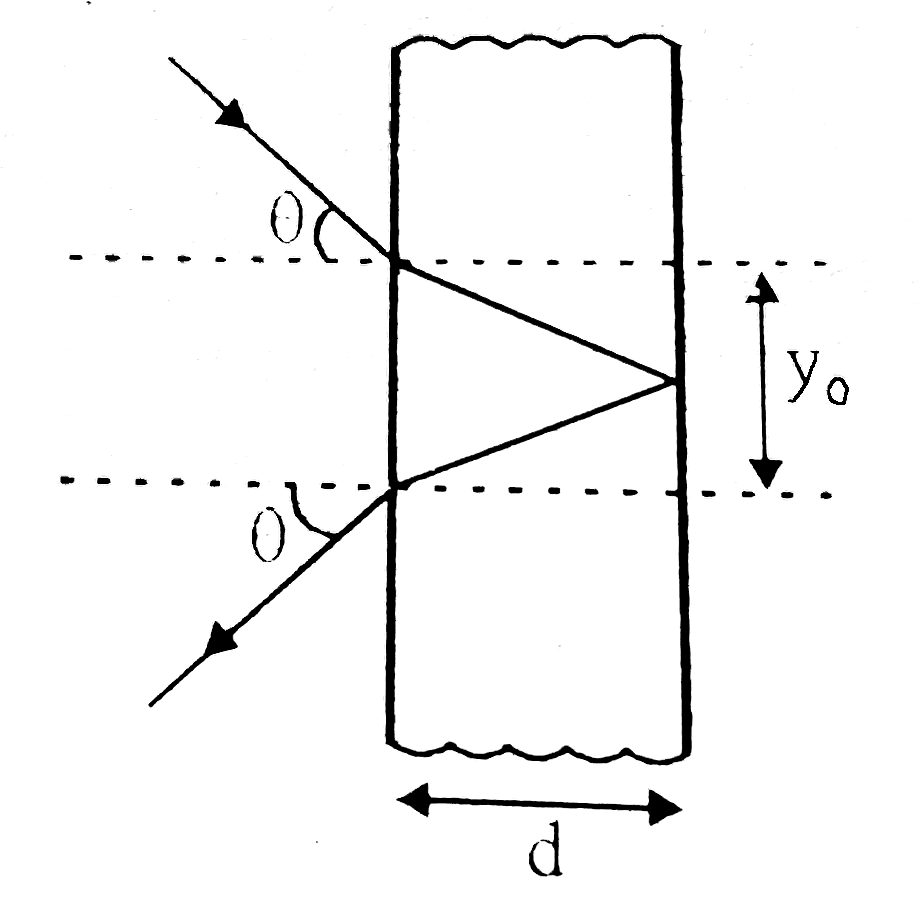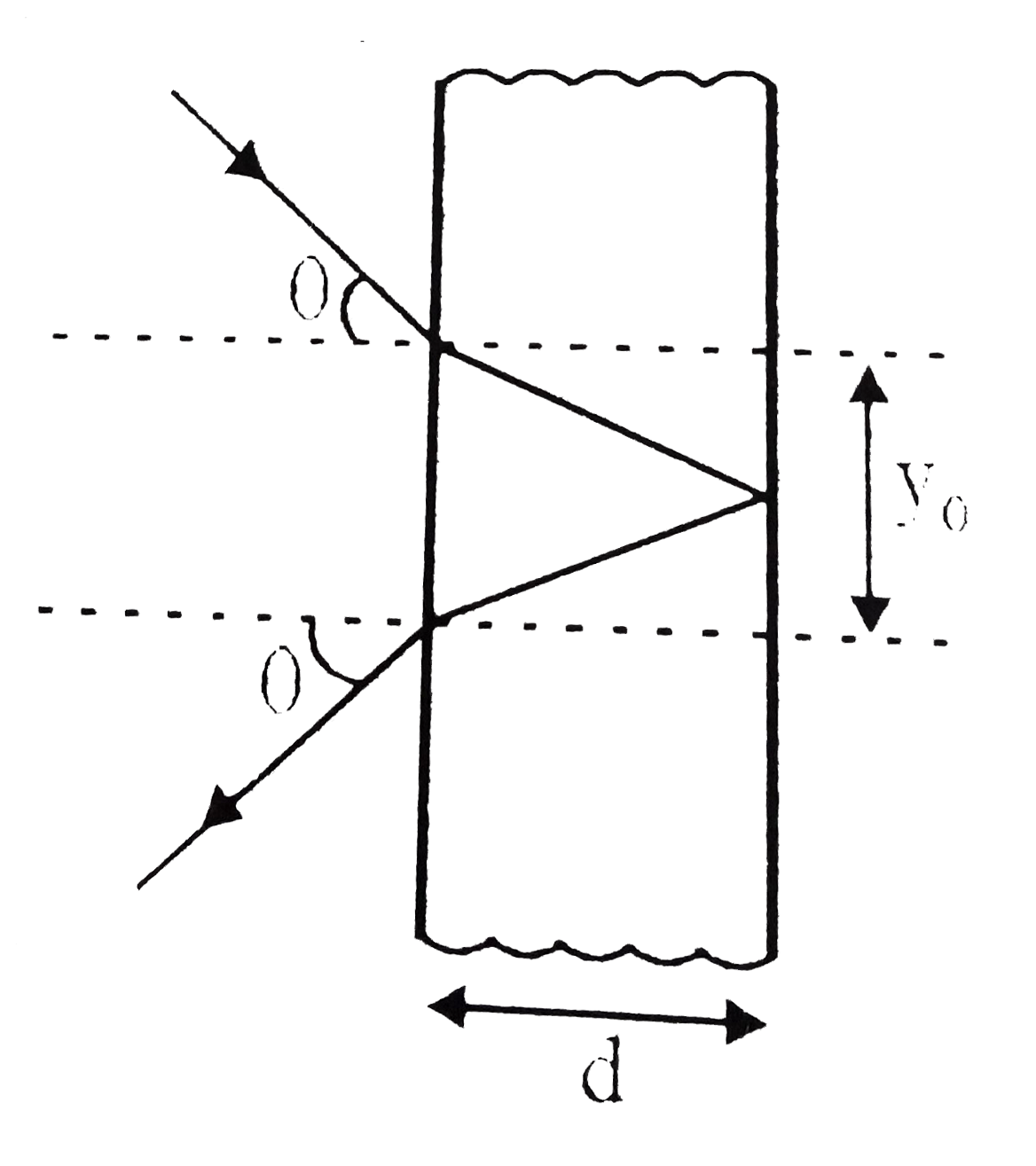Back surface of a glass (refractive index n and thickness t) is polished to work as a mirror as shown below. A laser beam falls on it and is partially reflected and refracted at the air-glass interface and fully reflected at the mirror surface respectively. A pattern of discrete spots of light is observed on the screen.

The spacing between the spots on the screen will be
2tcosθ√n2−sin2θ
2tsinθ√n2−sin2θ
2ttanθ√n2−sin2θ
2tsinθ√1−sin2θn2
The correct Answer is:A
Step by step video, text & image solution for Back surface of a glass (refractive index n and thickness t) is polished to work as a mirror as shown below. A laser beam falls on it and is partially reflected and refracted at the air-glass interface and fully reflected at the mirror surface respectively. A pattern of discrete spots of light is observed on the screen. The spacing between the spots on the screen will be by Physics experts to help you in doubts & scoring excellent marks in Class 12 exams.
Updated on:21/07/2023Topper's Solved these Questions
Similar Questions
A ray of light incident from air on a glass plate of refractive index n is partly reflected and partly refracted at the two surfaces of the glass. The displacement y0 in the figure is

View SolutionA glass of refractive index 1.5 is coated with a thin layer of thickness t and refractive index 1.8 . Light of wavelength λ travelling in air is incident normally on the layer. It is partly reflected at the upper and the lower surfaces of the layer. It is partly reflected at the upper and the lower surfaces of the layer ant the two reflected rays interface . If λ=648nm, obtain the least value of t(in10−8m) which the rays interface constructively.
View Solution
Knowledge Check
A ray of light incident from air on a glass plate of refractive index n is partly reflected and partly refracted at the two surfaces of the glass. The displacement y0 in the figure is
 A2dsinθ√n2−sin2θB2dsinθ√sin2θ−1n2C2d√n2−sin2θsinθDNone of these
A2dsinθ√n2−sin2θB2dsinθ√sin2θ−1n2C2d√n2−sin2θsinθDNone of theseA ray of light strikes an air-glass interface such that a part of it is reflected into air and the rest enters glass as shown in the figure below.

If angle of refraction and refractive index of glass with respect to air is r and μ respectively,then value of α isArBμ sin rCsin−1(μsinr)Dsin−1(sinrμ)A cubical block of glass of refractive index n1 is in contact with the surface of water of refractive index n2. A beam of light is incident on vertical face of the block. After refraction a total internal reflection at the base and refraction at the opposite face take place. The ray emerges at angle θ as shown. The value of θ is given by
 Asinθ<√n21−n22Bcosθ<√n21−n22Csinθ<1√n21−n22Dcosθ<1√n21−n22
Asinθ<√n21−n22Bcosθ<√n21−n22Csinθ<1√n21−n22Dcosθ<1√n21−n22
A light ray is incident perpendicularly to one face of a 90∘ prism and is totally internally reflected at the glass-air interface. If the angle of reflection is 45∘, we conclude that the refractive index n

View SolutionA slab of glass, of thickness 6 cm and refractive index μ=1.5 is placed in front of a concave mirror as shown in the figure. If the radius of curvature of the mirror is 40 cm and the reflected image coincides with the object, then the distance of the object from the mirror is

View Solution_S01_028_Q01.png)
In the figure shown S is a point monochromatic light source of frequency 6×1014Hz.M is a concave mirror of radius of curvature 20 cm and L is a thin converging lens of focal length 3.75 cm AB is the principal axis of M and L.
Light reflected from the mirror and refracted from the lens in succession reaches the screen. An interference pattern is obtained on the screen by this arrangement.
Q. Distance between two coherent sources whichmakes interference pattern on the screen is
View SolutionConsider a ray of light incident from air onto a slab of glass (refr active index n) of width d, at an angle θ . The phase difference between the ray reflected by the top surface of the glass and the bottom surface is
View SolutionAn object is placed 21 cm in front of a concave mirror of radius of curvature 10cm. A glass slab of thickness 3cm and refractive index 1.5 is then placed close to the error in the space between the object and the mirror. The distance of the near surface of the slab from the mirror is 1cm. The final image from the mirror will be formed at
View Solution
